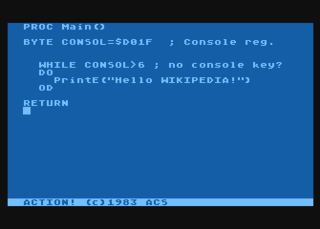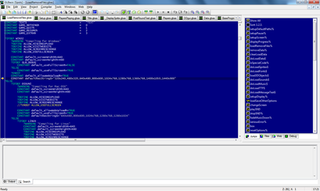Related Research Articles

In computer programming, assembly language, often referred to simply as assembly and commonly abbreviated as ASM or asm, is any low-level programming language with a very strong correspondence between the instructions in the language and the architecture's machine code instructions. Assembly language usually has one statement per machine instruction (1:1), but constants, comments, assembler directives, symbolic labels of, e.g., memory locations, registers, and macros are generally also supported.

In electronics and computer science, a reduced instruction set computer (RISC) is a computer architecture designed to simplify the individual instructions given to the computer to accomplish tasks. Compared to the instructions given to a complex instruction set computer (CISC), a RISC computer might require more instructions in order to accomplish a task because the individual instructions are written in simpler code. The goal is to offset the need to process more instructions by increasing the speed of each instruction, in particular by implementing an instruction pipeline, which may be simpler to achieve given simpler instructions.
Turbo Pascal is a software development system that includes a compiler and an integrated development environment (IDE) for the programming language Pascal running on the operating systems CP/M, CP/M-86, and DOS. It was originally developed by Anders Hejlsberg at Borland, and was notable for its very fast compiling. Turbo Pascal, and the later but similar Turbo C, made Borland a leader in PC-based development tools.
OCaml is a general-purpose, high-level, multi-paradigm programming language which extends the Caml dialect of ML with object-oriented features. OCaml was created in 1996 by Xavier Leroy, Jérôme Vouillon, Damien Doligez, Didier Rémy, Ascánder Suárez, and others.
Bytecode is a form of instruction set designed for efficient execution by a software interpreter. Unlike human-readable source code, bytecodes are compact numeric codes, constants, and references that encode the result of compiler parsing and performing semantic analysis of things like type, scope, and nesting depths of program objects.
Csound is a domain-specific computer programming language for audio programming. It is called Csound because it is written in C, as opposed to some of its predecessors.

The device independent file format (DVI) is the output file format of the TeX typesetting program, designed by David R. Fuchs and implemented by Donald E. Knuth in 1982. Unlike the TeX markup files used to generate them, DVI files are not intended to be human-readable; they consist of binary data describing the visual layout of a document in a manner not reliant on any specific image format, display hardware or printer. DVI files are typically used as input to a second program which translates DVI files to graphical data. For example, most TeX software packages include a program for previewing DVI files on a user's computer display; this program is a driver. Drivers are also used to convert from DVI to popular page description languages and for printing.
In computers, a printer driver or a print processor is a piece of software on a computer that converts the data to be printed to a format that a printer can understand. The purpose of printer drivers is to allow applications to do printing without being aware of the technical details of each printer model.
A fat binary is a computer executable program or library which has been expanded with code native to multiple instruction sets which can consequently be run on multiple processor types. This results in a file larger than a normal one-architecture binary file, thus the name.
MBASIC is the Microsoft BASIC implementation of BASIC for the CP/M operating system. MBASIC is a descendant of the original Altair BASIC interpreters that were among Microsoft's first products. MBASIC was one of the two versions of BASIC bundled with the Osborne 1 computer. The name "MBASIC" is derived from the disk file name MBASIC.COM of the BASIC interpreter.

Action! is a procedural programming language and integrated development environment written by Clinton Parker for the Atari 8-bit computers. The language, which is similar to ALGOL, compiles to high-performance code for the MOS Technology 6502 of the Atari computers. Action! was distributed on ROM cartridge by Optimized Systems Software starting in 1983. It was one of the company's first bank-switched 16 kB "Super Cartridges". The runtime library is stored in the cartridge; to make a standalone application requires the Action! Toolkit which was sold separately by OSS.
Optimized Systems Software (OSS) was a company that produced disk operating systems, programming languages with integrated development environments, and applications primarily for Atari 8-bit computers. The founders of OSS previously developed Atari DOS, Atari BASIC, and the Atari Assembler Editor for Atari, Inc., and many OSS products are substantially improved versions. OS A+ and DOS XL are based on Atari DOS. BASIC A+, BASIC XL, and BASIC XE are based on Atari BASIC. EASMD and MAC/65 are modeled on the Atari Assembler Editor. Action! is an ALGOL-inspired compiled programming language with an integrated full-screen editor. OSS also sold some software for the Apple II.

Racket is a general-purpose, multi-paradigm programming language. The Racket language is a modern dialect of Lisp and a descendant of Scheme. It is designed as a platform for programming language design and implementation. In addition to the core Racket language, Racket is also used to refer to the family of programming languages and set of tools supporting development on and with Racket. Racket is also used for scripting, computer science education, and research.

The Parallax P8X32A Propeller is a multi-core processor parallel computer architecture microcontroller chip with eight 32-bit reduced instruction set computer (RISC) central processing unit (CPU) cores. Introduced in 2006, it is designed and sold by Parallax, Inc.

FutureBasic is a free BASIC compiler for Apple Inc.'s Macintosh.

GLBasic is a commercial BASIC programming language that can compile to various platforms including Windows, Linux, Mac OS X, and some handheld devices. The language is designed to be simple and intuitive.
The Perl virtual machine is a stack-based process virtual machine implemented as an opcodes interpreter which runs previously compiled programs written in the Perl language. The opcodes interpreter is a part of the Perl interpreter, which also contains a compiler in one executable file, commonly /usr/bin/perl on various Unix-like systems or perl.exe on Microsoft Windows systems.

MAC/65 is a 6502 assembler written by Stephen D. Lawrow for the Atari 8-bit family of home computers. MAC/65 was first released on disk by Optimized Systems Software in 1982, with the program requiring 16 KB RAM. A bank switched "SuperCartridge" from OSS followed in January 1984 for US$99, occupying only 8 KB.

A BASIC interpreter is an interpreter that enables users to enter and run programs in the BASIC language and was, for the first part of the microcomputer era, the default application that computers would launch. Users were expected to use the BASIC interpreter to type in programs or to load programs from storage.
References
- ↑ Broadway & Seymour's WinPrism To Debut in Early 1997 (press release), The Free library, 15 October 1996.
- ↑ Banks form front line in battle for operating system dominance, By Thomas Hoffman, Computerworld 27 Feb 1995, Page 41, ...Indeed, most...third-party branch banking packages originally written for OS/2...have been rewritten for Windows, for example, Charlotte, N.C. based Broadway and Seymour, Inc's BancStar platform automation package will ship for Windows later this year...
- 1 2 Loughry, Joseph ‘Joe’, "BANCStar", The Turing Tarpit, Reo cities, archived from the original on 2011-07-25, retrieved 2010-05-16.